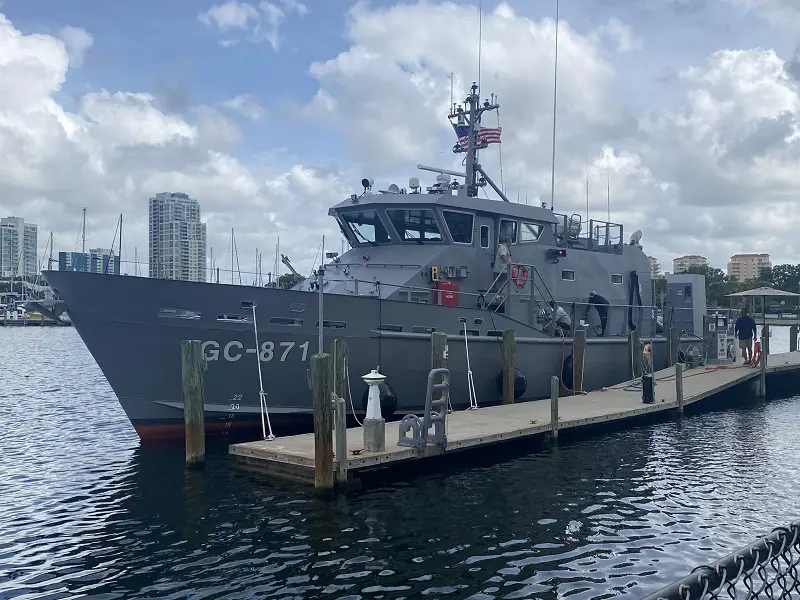Metal Shark has successfully developed the 85 Defiant Class Near Coastal Patrol Vessels (NCPVs) to bolster the maritime defense capabilities of several US partner nations. This groundbreaking initiative took shape when the esteemed Naval Sea Systems Command (NAVSEA) of the US Navy awarded Metal Shark a prestigious contract in June 2017. Under this foreign military sales (FMS) agreement, Metal Shark was entrusted with the construction of up to 13 85ft NCPVs, coupled with the delivery of state-of-the-art electro-optical infrared sensors, comprehensive in-country reactivation, crew familiarisation, and rigorous testing services. The latest achievement in this endeavor involves the imminent delivery of the Model 85-Defiant vessel, with the designated code GC-871, to Guatemala. This remarkable vessel is the sixth addition to the Near Coastal Patrol Vessel (NCPV) program that Metal Shark has diligently implemented since 2017. Embarking on an epic voyage spanning 3,000 nautical miles, the GC-871 shall gracefully traverse the distance from Metal Shark’s headquarters in Franklin, Louisiana to its final destination at Guatemalan Naval Base in San José, Escuintla, Guatemala.
The NCPV program, at its core, aims to provide up to thirteen cutting-edge vessels to enhance the maritime security capabilities of the recipient nations. The first vessel of the 85-Defiant class was successfully delivered to the Dominican Republic, marking a significant milestone in this vital initiative. Subsequently, the second vessel found its way to El Salvador, while the third vessel was handed over to Honduras in almost simultaneous fashion. Furthermore, the fourth vessel was entrusted to Panama, and the fifth vessel now serves Costa Rica. Notably, Costa Rica has expressed its intention to acquire a second vessel, showcasing their recognition of the outstanding performance and effectiveness of the NCPVs. However, it is worth mentioning that El Salvador has not been offered a similar option, despite their involvement in two significant high-seas drug raids between June and July. The 85 Defiant Class NCPVs stand as a testament to the company’s unwavering dedication to ensuring the safety and security of partner nations and the international maritime community as a whole. As Metal Shark continues to forge ahead, the world eagerly awaits the next milestones in this groundbreaking program, poised to shape the future of coastal defense.

The 85 Defiant NCPV is based on the Damen Stan Patrol 2606 platform. The base design has been enhanced by Metal Shark to achieve crew-friendly functionality. The all-welded aluminium vessel will integrate a deep V-hull with raked bow, wide inverted chines and spray rails. It will offer superior durability and seakeeping, large payload capacity, and economical operations. Its crew can access a surefooted passage to safely traverse between bow and stern. Non-skid walkways on board the vessel will feature low-level LED lighting for operations at night. The water-tight manholes and access hatches will allow the crew to enter tanks and machinery areas, while the vessel will also integrate stern ladders for accessing water. The wheelhouse of the vessel will have pillarless glass and large spotter windows for a high field of view. It will be fitted with openable side and aft pilothouse windows to enable crew communication during docking and manoeuvring beside another vessel. Each vessel will have a length of 26.5m, beam of 6.2m, depth of 3.3m, and maximum draught of 1.8m.
The cargo-carrying capacity of the deck will be up to 4t, while the total deadweight of the vessel, including fuel, personnel, cargo and equipment, will be 20t. The vessel can also carry 55-gallon drums securely within ejection racks. Its modern, crew-friendly design will offer comfortable accommodation for more than ten personnel to support missions at sea for extended time periods. The large aft deck of the vessel can house a 5.5m-long, ten-person rigid-hulled inflatable boat (RHIB). The integrated stern slipway on board the vessel will enable the launch and recovery of the boat. The vessels will be powered by two MTU main engines, developing a total power output of 3,260bkW at 2,000rpm. Each engine is coupled to a fixed-pitch propeller through a Reintjes gearbox. The engine room will be equipped with a fire-fighting system. The propeller tunnels will be integrated into the aft running surface to achieve improved performance as well as reduced draft, noise and vibration. The shipboard power will be supplied by generator sets, and the propulsion system will provide a speed of 28k.















